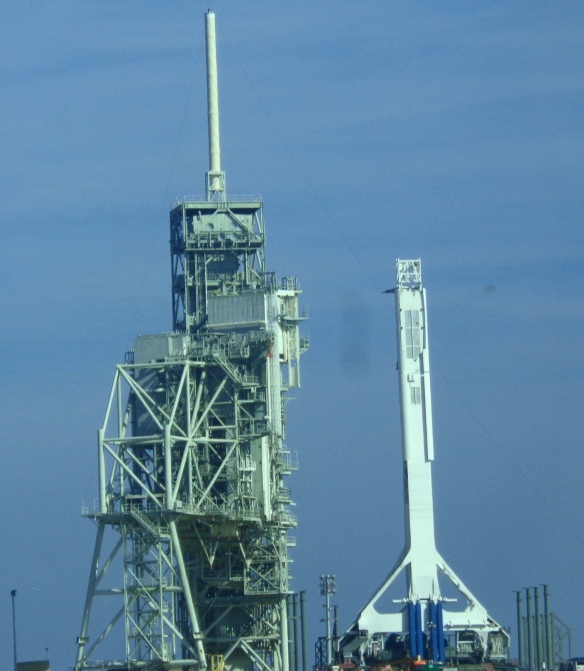We have made several visits to the Kennedy Space Center Visitor Complex on Merritt Island, just south of Titusville, Florida. There are plenty of things to see and do, and a few exhibits are under construction, so we will have more to explore next year when we return to Florida. The visitors complex is separate from the Kennedy Space Center (KSC). The visitors center is operated by an outside firm, and does not receive any government funding. I will break up my blog into several posts, starting with the future of space exploration.
NASA continues to operate at the space center. Some people are surprised by this, and think the space program was cancelled due to budget cuts from Congress several years ago. They are no longer flying the Space Shuttle, as it had completed its two main missions: build the International Space Station, and launch and repair the Hubble Telescope. NASA has partnered with private companies such as SpaceX and Boeing to continue servicing the Space Station and sending satellites into orbit. Both of the private companies are planning on sending manned trips to the Space Station. Currently the United States has to pay Russia to send our astronauts up there.
NASA is focused on the next generation of space travel and exploration. They are working on the most powerful rocket ever built, Space Launch System (SLS) and a new space craft, Orion, which will go to Mars. The first launch, called Exploration Mission – 1, is tentatively scheduled for 2018.
There is a bus trip that takes you around KSC, as part of the admission to the Visitors Center. The most famous building, visible for miles, is the 526 feet tall Vehicle Assembly Building (VAB). This building was constructed in the 1960s and was used for both the Apollo and Shuttle programs. It is now being modified for use to assemble Orion and SLS.

Vehicle Assembly Building front view
This view below shows the side where the rocket exits the building and moves down the gravel road to the launch pad. The building on the left is the launch control center. Once the space craft and rocket booster has been assembled in the VAB, it will be moved down to the launch pad on a giant mover vehicle.


vehicle mover
Construction is underway on the launch tower for the SLS. This tower will eventually be moved to the launch pad.

NASA will be using launch pad 39B, which was used for both the Apollo and Shuttle programs. They are currently demolishing the old launch facility, and building a new tower to be placed on the launch pad. This is the current view of pad 39B. The towers that you see are lightning rods.

SpaceX has obtained a 20 year lease to use launch pad 39A. They recently launched Dragon-9 which carried supplies on a trip to the Space Station. It was the first time this pad has been used in years. The white tower on the right in the picture below is what they use for their rocket launch pad. The tower on the left is what remains from the shuttle program.

The bus tour is very informative, both for the history and the future of the space program. For an additional charge, there are several more in-depth tours that you can take. We plan on doing this next year when we return, to see what has developed with Orion. NASA has a model of the 364 feet spacecraft and rocket on the tower. The spacecraft would be at the top of the model, just above the NASA logo.

Below is what the Orion spacecraft will look like. The base is 16 feet in diameter. It can carry 4 – 6 astronauts.

Orion model
NASA currently has 3 rovers on Mars. They have models of all three on display in their newest exhibit, Journey to Mars. The smallest, Sojourner, landed in July of 1997, and broadcast images until September 1997.

Sojourner Rover
In January of 2004, two rovers landed on opposite sides of Mars. The Spirit mission ended March 2010, but Opportunity continues to roam around.

Spirit/Opportunity Rovers
The larger Curiosity Rover is about the size of an ATV, and it landed in August of 2012. It will break down and “digest” rock samples and send back data on what it “ate”.

Curiosity Rover
It will be exciting to follow along on NASA’s progress in the Journey to Mars. Right now they estimate sending humans to Mars in the 2030’s. Stay tuned for additional posts on the center.
Quote of the Day: “Mars has been flown by, orbited, smacked into, radar examined, and rocketed onto, as well as bounced upon, rolled over, shoveled, drilled into, baked and even blasted. Still to come: Mars being stepped on.” – Buzz Aldrin, from his 2013 book, Mission to Mars: My Vision for Space Exploration.

Gr8 post on your visit to KSC !! Very interesting info, too ! Thanks for sharing , you guys.
Hugs,
Jer
________________________________
KSC is really cool. Orion is really going to be fun to follow!
Plan to go there sometime. Glad you are enjoying it.
Pingback: NASA: Apollo Saturn V | Liv2RV